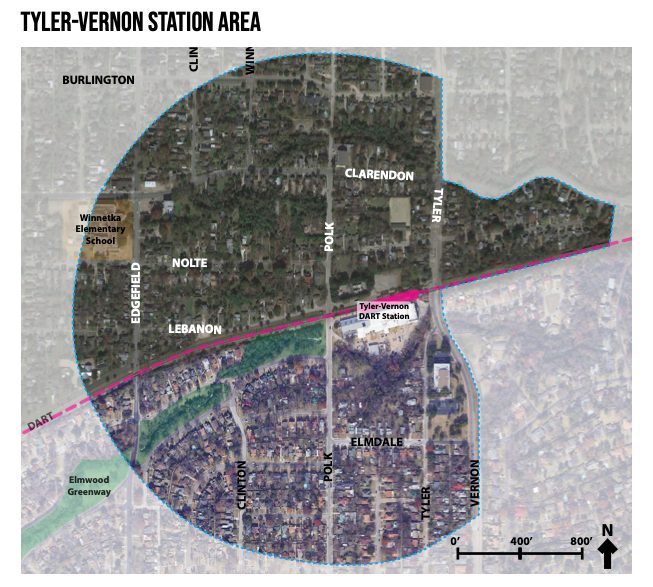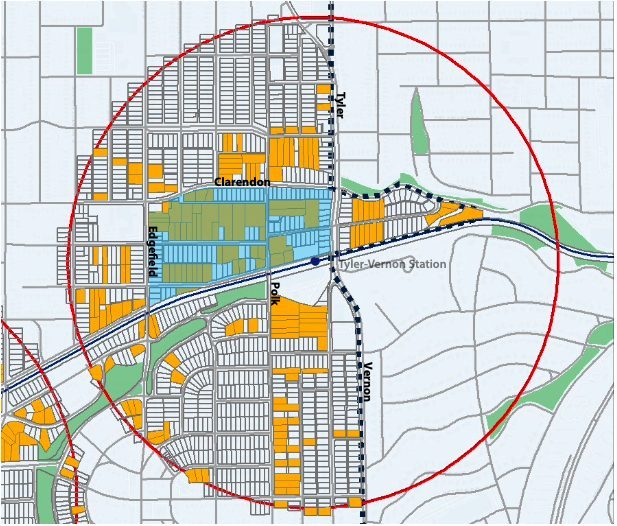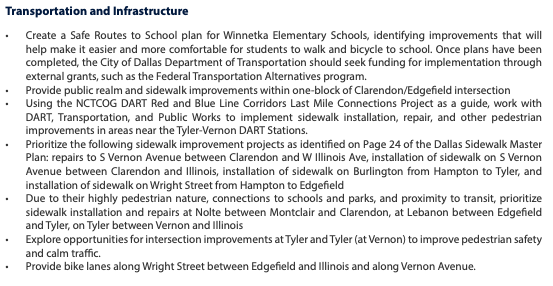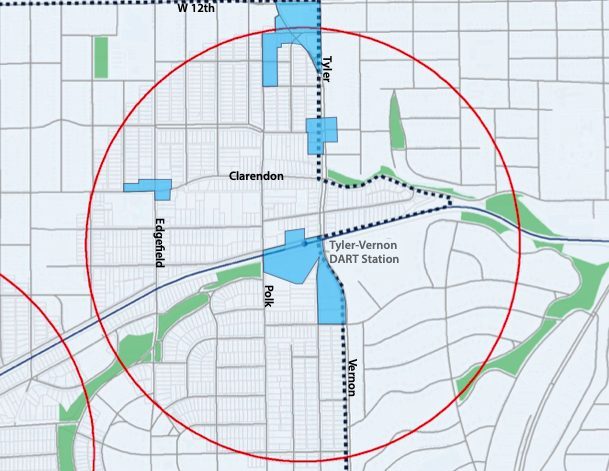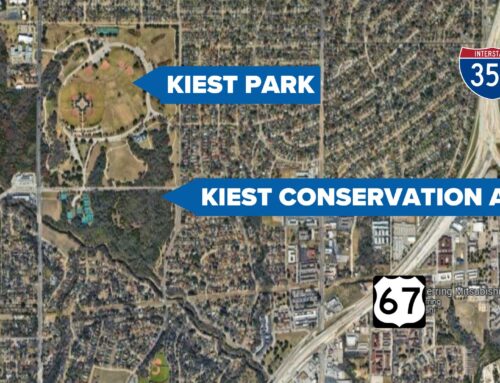What does the West Oak Cliff Area Plan say about the Tyler-Vernon Station area?
The first draft of the plan, recently released, identifies several neighborhood focus areas. We’re walking our neighbors through all of them this week. We started with Elmwood’s commercial district. This is part two.
Read the draft plan and give feedback here.
Tyler/Vernon is the part of the plan that sparked political debate and community outrage last year, and it gave birth to a neighborhood movement.
Neighbors near Tyler Station organized when it came to light that some property owners want to increase building heights to allow townhomes or apartments.
The Polk Vernon Neighborhood Association’s president, Yolanda Alameda, served on the West Oak Cliff Area Plan’s community task force, which logged about 26 hours of meetings.
Mayra Chavez lives on Polk at Clarendon, and investors recently purchased property near a church at the northeast corner. Her home is at the crux of where the draft recommends allowing future townhome development.
The City of Dallas Office of Planning and Urban Design emphasizes that this is a draft, and staff will continue to meet with neighborhood groups over the next six weeks or so to work out details of the next draft. None of this has been decided. The deadline for neighbors to comment on the plan is May 10.
Neighbors started the West Oak Cliff Coalition to advocate for Spanish communication throughout the planning process.
Coalition members knocked on doors and distributed printed materials to encourage their neighbors’ involvement in the plan.
Chavez saw how townhomes built at the roundabout on Tyler at Canty changed the look of that area. It inspired her to act because she doesn’t want encroaching development to leave her home as the last house on a block filled with three-story townhomes.
“We would like to stay here and have our home passed through the generations,” she says.
The Polk Vernon Neighborhood Association meets at 11 a.m. Saturday, March 26, at the Church of Jesus Christ of Latter-day Saints to discuss the draft of the plan.
Accessory Dwelling Units
Polk Vernon neighbors have more organizing ahead of them. Gaining conservation district status with the City of Dallas is one of the top recommendations the draft makes for this neighborhood.
Conservation districts allow neighbors to shape development standards for their area, but the draft specifically recommends using a conservation district or overlay as a way to allow more housing density.
Within 1⁄2 mile of the Tyler-Vernon DART Station, modify the zoning through conservation districts or an overlay tool to permit missing-middle housing types, including accessory dwelling units, duplexes, and triplex/ quadplexes, narrow-lot single-family, and cottage homes (where applicable) to be allowed by-right, adhering to architectural and urban design standards to be determined on a neighborhood basis. Development will be required to follow existing city codes related to ADUs, parking requirements, setbacks, and massing standards.
The draft plan generally recommends as a land-use goal increasing housing opportunities throughout West Oak Cliff through “accessory-dwelling units,” or rear apartments. It is also suggested in the draft that property owners could convert or replace homes with duplexes, triplexes or quads. [Correction: An earlier version of this post erroneously described the city’s rules for accessory-dwelling units. They can be one unit with a maximum of 700 square feet.]
Townhomes
The area shaded in aqua and moss in the map above, bounded by Clarendon, Tyler, Edgefield and the DART tracks, is recommended in the draft for future townhouse development as high as 3 stories, while protecting single-family homes via the building ratio known as “residential proximity slope.”
As an alternative to or in addition to the recommendation for allowing additional missing-middle housing types, explore a future rezoning for the area bounded by Edgefield, Clarendon, Tyler, and the DART tracks to permit townhome development and multifamily development up to three-stories in height, maintaining existing proximity slopes and providing appropriate setbacks and design standards to fit contextually into the surrounding neighborhood.
Transit-oriented walkability
Weekly ridership at the Tyler/Vernon DART station is the lowest of any station in Dallas, according to the draft plan, “with just 1,696 riders per week reported in 2017, an average of roughly 240 riders per day.”
It adds this statistic about the area, which comprises about 200 acres: “The Tyler Vernon Station Area currently has the largest percentage of single-family zoning in the entire city, with over 80% of the area zoned for single- family uses.”
Low housing density and a lack of businesses providing employment in the neighborhood has led to low ridership, the draft states.
While the Elmwood Parkway Trail now begins at Tyler Station, the neighborhood is not pedestrian friendly otherwise.
Bike lanes are called for on Wright and Vernon, the draft states. And the trail could be extended along Elmwood Branch creek to Vernon, “along with a possible pocket park.”
A safe route to school is needed for Winnetka Elementary, which could be achieved through North Texas Council of Government and City of Dallas funding.
The council of governments and DART could also use “last-mile” funding to create pedestrian improvements within a mile radius of the station.
The draft plan also prioritizes sidewalk improvements, many of which are laid out in the Dallas Sidewalk Master Plan.
Parking relief
The City of Dallas has been considering reforming its parking code to make requirements less strict in urban areas. The West Oak Cliff plan draft states that parking restrictions should be lessened or removed for older commercial buildings, which are called “legacy structures.”
The neighborhood has only a few commercial areas. Besides Tyler Station, there are is a retail node at Clarendon and Edgefield, as well as a single retail strip on Tyler at Burlington, plus retail developments at Tyler and Page.
The draft recommends easing parking while being mindful of how spillover could affect the neighborhood.
All rezonings in this area should consider opportunities for parking reductions due to the proximity to transit. This should strongly be considered for existing legacy commercial structures that might not have ample parking available due to their lot size and may subsequently struggle finding tenants. All parking amendments should also be mindful of potential spillover impacts into surrounding neighborhoods.
It also goes a step further, in recommending parking relief for residential and office uses.
In conjunction with citywide parking code reform, consider parking code reductions for all commercial, residential, and office uses within 1⁄2 mile of the Tyler-Vernon DART Station to enable more financially-viable development in these areas and to produce more walkable, pedestrian-oriented development in the future.
Parks and green space
Besides the idea for a pocket park near the corner of Tyler and Vernon, the draft makes one other recommendation for creating more green space in this neighborhood.
Burlington Boulevard has broad medians that could be used as park space, such as on Historic Swiss Avenue.
Support local neighborhood organizations in working to explore MOWmentum Agreements to turn the large medians along Burlington into publicly usable spaces, providing landscaping, street trees, benches and other amenities as desired by the neighborhood.

